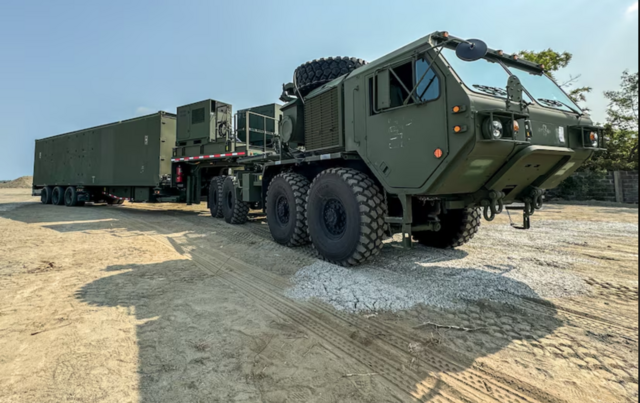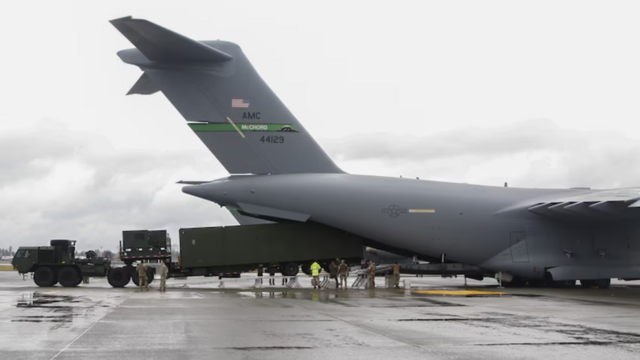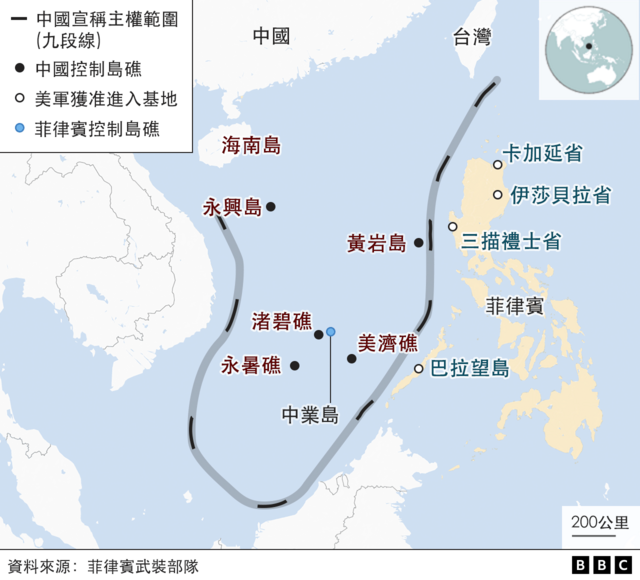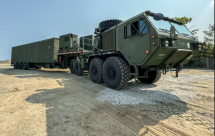
Image source, US Army Pacific
According to the US Navy News, the US Army's new land -based missile launch system has recently deployed in northern Philippines.Participate in the two-week "Salaknib 24" joint exercise.
However, this time this new land -based missile system debuted in the "First Island Chain".Zone and sensitive South China Sea and Taiwan Strait.Experts seize a warning to China and convey the military defense capabilities of the United States in the Indo -Pacific region.
At the same time, in response to the US actions, Zhongnanhai also released a high -profile counter -signal, publishing the news that there is a military dialogue with Cuban military executives in Beijing, which is very strong.The intense wrestling of the relationship.
According to Reuters, the annual Philippine and the United States' "Balikatan" exercise will appear next Monday (April 22).In addition to the US Coast Defense Force, the Philippine Maritime Defense Force will also participate in this large joint military exercise for the first time.
Institute of Defence and Strategic Studies, a senior researcher, said to Dr. Collin Koh, a senior researcher of the InstituteThis system is characterized by moving, which can be equipped with heavy transport aircraft, and can be quickly deployed to the combat area in a short time.
A typical "Di Feng" artillery force is not an independent unit, but a larger unit, such as the multi -domain task force of the US Army.The Tomahawk missile launched by the system has a medium -range strike capability and can carry out remote depth of high -value enemy targets, such as command control centers, ammunition depot and airport.
Xu Ruilin said: "Its range is farther than weapons such as the Army Tactical Missile System (ATACMS). The Ukrainian war shows the difficulty of cracking down on such a mobile system., Also known as Hemimas) survived on the battlefield for a long time, and was not successfully destroyed by Russia until recently.
Dr. Sasteru Nagao, a non -long -tier researcher at the Hudson Institute of Washington Think Tank, told that the deployment of the "Titian" system can be used to deal with the military conflict of the Taiwan Strait.
He said that the system is the latest land-based missile launch system that can launch Tomahawk cruise missiles or "standard six air defense missiles" SM-6 (more precisely, it is a standard long-range missile RIM-174B) missile missile missile missile.Attack land or sea targets.In this case, "Standard Sixth Air Defense missiles" can be used not only for air combat, but also to attack land and maritime targets.
What is the "Ti Feng" system?
According to reports, the "Tifeng" weapon system is a medium-range capacity land-based missile launch system, which can be equipped with Tomahawk cruise missiles and "standard six" (SM-6) missiles.This military system is designed by Lockheed Martin in the United States. It uses the US Navy's MK-41 vertical launch system and modified it for land-based operations.
According to the US Navy News Network, these launch systems are one of the core elements of the US Army's new multi -field special teams (MDTF); the troops are mainly used to respond to a broad threat caused by Russia and China.
Changwei Xian told that compared with maritime ships, land -based vehicles such as the "Tifeng" system have the advantages of being able to move, re -cover, loading and launching missiles.Load.Long -tail Xian explained that a land -based missile launcher means a repeated missile attack, which is an important feature.
He pointed out: "If there is a conflict between the Taiwan Strait, when the PLA attacks Taiwan, many air force bases need to be used. However, if the missile attacks the runway, Chinese bombers will be temporarily unable to take off and land.It can interfere with China's air operations against Taiwan, not only for the Air Force Base, but also for maritime ships.
The distance between Manila and Hong Kong is about 1,000 kilometers, the distance between Hainan Island is about 1300 kilometers, and the distance between Taipei is about 1,200 kilometers.According to analysis, the range of the Tomahawk cruise missile launched from the ground launchers is 1300 to 1700 kilometers. The actual launch distance depends on the environmental conditions of the version and the launch of the missile.
Professor Xu Ruilin, a strategic scholar of Singapore, told that to fight against such a system, considering its mobility and easier to disperse deployment, it is necessary to have real -time identification, tracking and strike its effective ability.In recent decades, the Chinese People's Liberation Army has been working hard to establish a reliable intelligence, surveillance and reconnaissance system to perform these functions, but he is not sure how it has effect.
But Professor Xu emphasized that if the system is deployed to the northern part of the Philippines, the scope of its strike not only cover the coastline of the eastern part of China, but also go deep into its inland.Place.
In addition, this system also includes the South China Sea, which can specially target artificial islands on the Nansha Islands.Xu Ruilin said: "Generally speaking, the 'Titian' system has given Americans a new ability." That is, since the implementation of the "rebalancing" strategy of the United States for a period of time, the strong ballistic and cruise missile inventory of the Chinese PLA can be used.The United States and the Allied Army combat the second island chain centered on Guam along the first island chain and more eastern.

Image source, US Army Pacific
However, Professor Xu added that the latest deployment seemed to verify that the United States could quickly deploy the system into the expected theater, as they did in the joint exercises in the Philippines in recent years: "I don't think Manila will allow the permanent deployment of the "Tifeng" system under the existing mutual defense arrangement with the United States, but it is more deployed as needed.
Changwei Xian told that in the final analysis, the deployment of this missile system is not carried by nuclear warheads, nor is it aggressive.At present, more than 2,000 medium-range (500-5500 kilometers) cruise missiles, ballistic missiles and hypersonic missiles have been deployed in China's industry, and the number has increased sharply in recent years.Therefore, the United States, Japan, the Philippines, Taiwan, Australia, India, and Vietnam are increasing the number, but China's deployment is indeed faster.
Beijing counter -citizen United States and Philippine alliance
After the United States issued the "Ti Feng" system in Luzon Island, China also responded immediately.According to the statement of the Ministry of National Defense, He Weidong, vice chairman of the Central Military Commission of the Communist Party of China on April 15th, met with a visit to the Guo Communist Central Committee and the director of the Political Department of the Cuban Revolutionary Armed Forces of the Cuban Revolutionary Armed Forces in Beijing.The statement quoted He Weidong, saying that China will continue to support the construction of the Cuban army and "join hands to build a community of destiny in ancient times."
Everyone knows that in 1962, during the Cold War of the United States and the Soviet Union, the "missile crisis" occurred in Cuba had caused tension in the United States and Western countries, and the relationship between Havana and Washington has not been completely thawed.Some analysts believe that Beijing's countermeasures that the United States will bring the "Ti Feng" system to the South China Sea is a high -profile to CubaBringing Asia, swords refer to the United States, warning is strong.
However, Dr. Naga Hyun believes that this "Tifeng" missile system is only used to carry conventional warheads. The nuclear warhead version of the Tomahawk missile has been retired, so this is not a nuclear weapon system.
But he believes that as far as Chinese cognition is concerned, most of China's missiles can carry conventional warheads or nuclear warheads. China believes that the United States will do so. "This is a kind of between China and the United States.Misunderstanding.

However, Xu Ruilin emphasized that in fact, during the epidemic period a few years ago, when Washington first proposed to deploy this missile system in the region after the medium -range missile treaty, Beijing had already responded to it.However, the recent deployment of the "Ti Feng" system will definitely surprise Beijing.
He said: "Beijing has already expected that this may happen, especially considering the current dispute between the Philippines with China in the South China Sea.It is closer than other Philippine government since the end of the Cold War.
Xu Ruilin has therefore emphasized that so far, it has not seen Beijing's economic revenge on Manila. This is because economic relations are high -value chips that China has the Philippines.wise.
Shen Xuhui, an associate professor of international relations scholar and associate professor at the National Taiwan and Port International Research Center of Taiwan, believes that the Philippines is now represented by the former President Duterte and the current President President President President,Fierce political struggle?.
He believes that this round of US -China agents in Manila's offensive and defensive war will directly affect the results of the Philippines's mid -term elections in 2025.There will be a key impact that will affect the entire Asia -Pacific situation.



